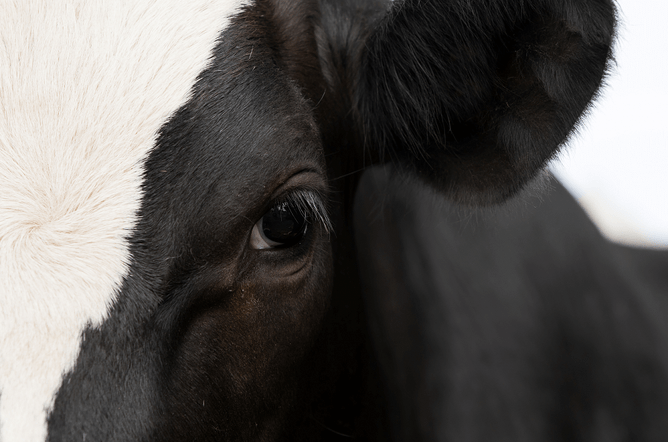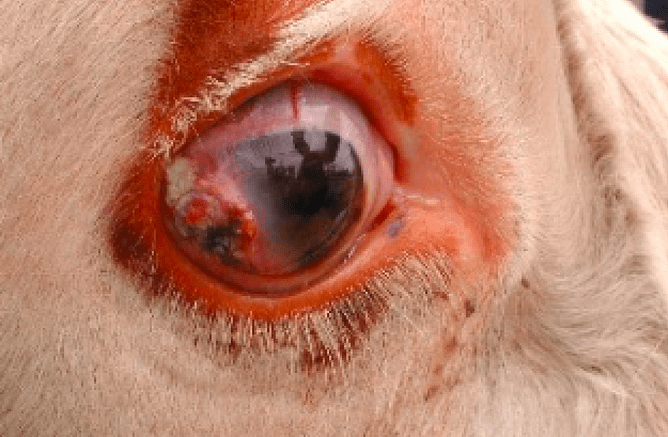How often do you look at your cows’ eyes? Have you ever seen something weird or unusual? It can be easy to miss changes and diseases of the eyes as we spend so much time focusing on the rear end of a cow.
As we know, cows are prey animals so they are programmed to hide all weaknesses for as long as possible. Often the only way to tell if a cow is blind is when she unexpectedly bumps into objects. Cows learn their environment so often you can’t tell if she is blind until she goes to a new environment e.g. to a grazing block for winter or on to a truck.
Clinical Signs and Causes of Eye Diseases
Changes in and around the eye can be subtle but also sometimes quite dramatic. Some diseases will affect the eyeball itself, particularly the cornea (surface of the eye). This can present as cloudiness or discolouration and can be caused by bacteria like Moraxella bovis (which causes pink eye - see fig 1) or Listeria monocytogenes (which causes silage eye). We can see similar changes from trauma, systemic viral diseases like Bovine Herpes Virus type I (which causes IBR) or from exposure to Ovine Herpes Virus type II (which causes Malignant Catarrhal Fever (MCF) in cattle).
The other main disease we see in the eye is squamous cell carcinoma, commonly known as cancer eye (see fig 2). These tumour cells typically start in the 3rd eyelid of a cow then will spread to the surrounding tissues. These can rapidly become quite nasty, often getting infected and as a result will smell terrible and can bleed a lot. More rarely these cancers can start in other eye tissues, but all will spread if action is not taken early.
The other eye conditions we get called to see are often in calves and can be congenital defects. Congenital cataracts can be caused by BVD virus, so if you have a calf with cataracts your KeyVet may decide to take a blood test from them to make sure they aren’t a PI (persistently infected) animal.
Welfare/trucking implications
Many diseases affecting the eyes are painful and as such are significant welfare issues. New Zealand has strict laws around the transportation of animals with eye diseases, so it is always best to check with your vet before you send an animal to the works (or anywhere on a truck).
Animals cannot be transported if they have:
- Eye cancer more than 2cm ($1 coin) in diameter
- Cancer not confined to the eye or eyelid
- Any bleeding or discharge (including pink eye lesions with pus)
- Blindness in both eyes
For any eye diseases, even ones that have recovered and may have left some scarring, it is always best to get your vet to examine the cow and write a transport certificate if she is suitable. Often these cows will have specific conditions to meet for being transported, such as being on the lower deck of the truck, with some herd mates and last on/first off.
How can we treat Eye Diseases?
Many eye disorders are treatable, particularly if picked up early. Bacterial diseases like pink eye or silage eye can be treated with topical antibiotic ointment, or if very bad your vet may need to give an injection into the eyelid tissue itself. Early stage cancer eye can be surgically removed; if the cancer is contained in the 3rd eyelid then the 3rd eyelid can be taken out, a reasonably quick and straightforward surgery. If the cancer has spread further then your vet will have to perform an enucleation, or eye removal surgery, where the entire eyeball and any other cancerous tissue is removed. Cows usually recover very well from this and can adapt to only having one eye very quickly. With cancer eye, the faster the cells are removed the higher the chance of a successful surgery. If the cancer cells have spread into the surrounding tissues, particularly the lymph nodes, there is a high chance that the cancer will come back and therefore the cow may need to be euthanised. Surgery can be performed to get an eye into a suitable state for transport after it has healed successfully.
So next time you’re getting the cows in, take a moment to look at their eyes. If you notice anything unusual, draft them out and have a closer look, then call your vet if it looks bad. We’re always keen to see weird and wonderful cases!
Fig 1: Pink Eye — Image by: (from “Diseases of Cattle in Australasia” Parkinson, Vermunt & Malmo 1st edition pg 617 Fig 16.3.3)
Fig 2: Cancer Eye — Image by: (from “Diseases of Cattle in Australasia” Parkinson, Vermunt & Malmo 1st edition pg 621 Fig 16.3.17)
- Christine Utting



